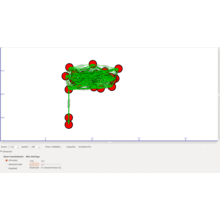SDN is specifically well-defined through the base knowledge of programmability. In this, it split up the control plane management from the data plane for forwarding the network traffic.
This page reveals the up-and-coming SDN Thesis Ideas in the current research technical advancements!!!
How does Software Defined Networking works?
SDN is destined to point out the fact that the static structural design of old-fashioned networks is distributed and difficult. Meanwhile, the current networks need more flexibility and easy troubleshooting mechanism for better performance. Also, it efforts to integrate system power in one integral by splitting the forwarding network packets from the routing operation. Particularly, the control plane is composed of more controllers which act as the SDN network intelligence. Though, smart centralism has some shortcomings like safety, scalability, and resistance which are considered as the chief problem of SDN Thesis.
In recent days, SDN has grown into a very important research area with a broad range of research topics. Here, we have given few current research topics in this area.
Interesting Software Defined Networking SDN Thesis Topics
- Load balancing in SDN
- SDN enabled 5G Mobile Networks
- Wireless Software Defined Networks
- SDN based Internet of Things (IoT)
- Artificial Intelligence (AI)-assisted SDN
- Service Function Chaining (SFC) in SDN
- Energy efficiency and Quality of Service in SDN
- VNF Orchestration along with Network Slicing
- Collaborating SDN with Vehicular Ad hoc Network
- Hierarchical Software Defined Networks Controllers
- Distributed Multi-domain Software Defined Networks
Why use SDN?
The main purpose of SDN is to share the application workloads using following factors,
- Automatic Provisioning
- Programmatic Management of Network
- Pervasive Application-Oriented Visibility
- Dedicated Integration with Cloud Orchestration Platforms
The motivating ideas behind the SDN development are myriad. For instance, it promises to decrease the complication of statically defined networks and create automatic network functions. And, it enables simpler provisioning and networked resources management in all the places starting from the data center to the wide-area network.

What are the technologies supported in SDN?
At present, various networking developments have engaged as essential SDN concepts. For instance, it distributes the processing power to remote sites, moving data center functions for the following,
- Drones / Unmanned Aerial Vehicles
- Internet of Things
- Edge
- Cloud Computing
- 5G and 6G networks
One and all efforts can be made simple and cost-effective through an appropriately designed SDN infrastructure. Several SDN controllers have the intelligence to monitor which network congestion is occurring. In response, it expands the bandwidth or processing to avoid latency in edge components.
In addition, we are ready to give add-on SDN Thesis Ideas in other applications as CloudNFV, smart home/healthcare system, smart sensor application, and IoT-based network solutions.
To acquire in-depth and fundamental information about the SDN field, our resource teams go through several recent textbooks. Since textbook is one of our learning resources for knowing all aspects of any research field. For sample, here we have listed few main textbooks specially meant SDN Thesis research domain.
From each book, we refer to the techniques, concepts, strategies, and protocols in SDN so those who looking for clear SDN thesis ideas, can simply contact us.
Important Textbooks available for SDN
- Novel Lifetime Extension Technology for Cyber‐Physical Systems Using SDN and NFV
- Author(s) – Hossam A. Gabbar
- Pages – 287 – 304, Publisher: Wiley-IEEE Press, Copyright Year: 2018, Edition: 1
- Description
- Utility and ability of SDN programmability and NFV deployment
- Intended to control the cyber‐physical systems topology and sensor modes
- Application of NFV and SDN to 5G Infrastructure
- Author(s) – Rath Vannithamby ; Shilpa Talwar
- Pages – 408 – 420, Publisher: Wiley Telecom, Copyright Year: 2017 , Edition: 1
- Description
- Comprehension about NFV and SDN technologies to signify the demands on 5G-cellular network
- Software Defined Security Monitoring in 5G Networks
- Author(s) – Madhusanka Liyanage ; Ijaz Ahmad ; Ahmed Bux Abro ; Andrei Gurtov ; Mika Ylianttila
- Pages – 231 – 243, Publisher: Wiley Telecom, Copyright Year: 2017 , Edition: 1
- Description
- Collaboration of SDN and NFV in 5G monitoring systems to reveal the legacy monitoring systems weaknesses
- SDN and NFV in 5G
- Author(s) – Ying Zhang
- Pages – 109 – 146, Publisher: Wiley-IEEE Press, Copyright Year: 2018, Edition: 1
- Description
- SFC supports the design of combined networks or services which holds well-organized Service Functions
- Contend with case studies of SDN-NFV’s instances in the 5G network
- Leveraging SDN for the 5G Networks
- Author(s) – Madhusanka Liyanage ; Andrei Gurtov ; Mika Ylianttila
- Pages – 61 – 80, Publisher: Wiley Telecom, Copyright Year: 2015 , Edition: 1
- Description
- Deals with the current challenges in the future scope of SDN‐5G networks
- Software‐Defined Optical Networks
- Author(s) – Devi Chadha
- Pages – 331 – 358, Publisher: Wiley-IEEE Press, Copyright Year: 2019 , Edition: 1
- Description
- SDN Architecture with software‐defined optical networking (SDON)
- QoE Management Framework for Internet Services in SDN‐Enabled Mobile Networks
- Author(s) – Madhusanka Liyanage ; Andrei Gurtov ; Mika Ylianttila
- Pages – 247 – 264, Publisher: Wiley Telecom, Copyright Year: 2015 , Edition: 1
- Description
- Debate on present QoS in mobile and SDN through flow‐based network‐centric QoE functions
- SDN‐Enabled Energy‐Efficient Network Management
- Author(s) – Konstantinos Samdanis ; Peter Rost ; Andreas Maeder ; Michela Meo ; Christos Verikoukis
- Pages – 323 – 338, Publisher: Wiley Telecom, Copyright Year: 2014 , Edition: 1
- Description
- Flexible resource adaption in the network devices
- Power management
- Network‐wide traffic loads optimization
- Openflow and SDN for Clouds
- Author(s) – Nelson L. S. da Fonseca ; Raouf Boutaba
- Pages – 129 – 152, Publisher: Wiley-IEEE Press, Copyright Year: 2015 , Edition: 1
- Description
- Introduces the OpenDaylight open-source development
- Incorporation of SDN and Cloud Computing services
- Software‐Defined Networks Principles and Applications
- Author(s) – Ying Zhang
- Pages – 67 – 108, Publisher: Wiley-IEEE Press, Copyright Year: 2018 , Edition: 1
- Description
- Detection and Mitigation of Interface and Programmable Attack
SDN is a line of attack for network administration that allows dynamic network configuration. And also, it is technically effective to advance the network performance. For the most part, it is nearer to cloud computing by way of an alternative to standard network supervision.
Take one step forward to make a contact with us; we let you know more thought-provoking SDN Thesis in the recent research world.

 Click Here to watch our latest output video using NS3 simulator
Click Here to watch our latest output video using NS3 simulator  Click Here to watch our latest projects screenshots using NS3 simulator
Click Here to watch our latest projects screenshots using NS3 simulator